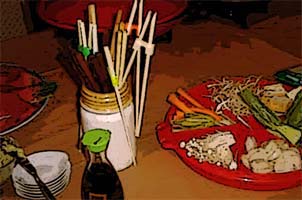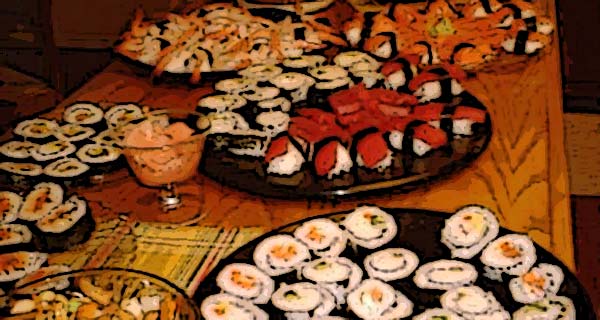Sushi, for me, is forever linked with one of my first loves. My discovery experience was in the early 1980s, when I went to the East Coast for the summer. While visiting friends in New York City, my boyfriend Mark took me to an extremely popular downtown Japanese restaurant ... I think it was downtown. Honestly, uptown and downtown pretty much had me confused the whole time I was there. The Village, I got, but the rest was a mish mash of buildings and exotic people. With water on both sides and no set of mountain ranges to give me compass points I just took a stab at where it could have been.

Allow me a minute to digress: my dad had been feeding us sukiyaki at home for years. Sukiyaki is slivers of beef and various vegetables cooked in a single broth-filled skillet. Later he was lucky enough to go on a business trip to Japan and picked up even more tips on what things you could put in the boiling pots, a delicious taste experience even today. So back then I had some idea of Japanese food, I thought; my passing familiarity with Japanese cuisine was pretty good. I was wrong.
Up until I went to New York, I had never experienced sitting at a table and having a feast for the eye delivered like a piece of artwork to be appreciated. Once both of us were seated formally in the lovely dining establishment, I let Mark order for us both since I had no idea what anything was on the menu. We sipped on sake, a warm rice wine, until small narrow ceramic plates arrived with slices of raw fish artfully arranged over rectangles of white rice and wisps of threads of radish. The fish topping I could understand immediately. As a California gal I had seen raw fish before; heck I had even caught my share of bass and trout. The pink and cream colored cuts of fish were perfectly aligned over the rice. Slabs of other bits of seafood were decorated with slivers of cucumbers and vegetables. There were mounds of bright pink slivers of something, next to the fish, which Mark explained was pickled ginger to be eaten either with the fish or afterwards to clear one's palate. Right next to the pink ginger was a small scoop of bright green paste. Mark quickly cautioned me it was a sort of Japanese horseradish not avocado.
Then Mark poured some of the soy sauce from the bottle on our table into a smaller dish that had been placed in front of each of us when they served our food. He dabbed some of the green paste into what looked like a small rectangular fingerbowl. Slowly he mixed it with his chopsticks the dark brown soy sauce until it was a muddy green color, thickened by the paste. I mimicked his making of a potion while wondering what all the fuss was about over this sort of Japanese food. The line to get in the restaurant had been long and if we had not had reservations, I overheard the hostess say to some other guests, there would have been over an hour wait for a table. I marveled at the idea, and figured it was just a New York thing; after all I had eaten fish undercooked, and it was okay, but nothing to rate a ceremony like this. Then I watched him place his chopsticks along the sides of one of the pairs of matching fish and rice bits with the fish side up, and carefully lift it from the platter. Deftly he slid the fish upside down into the fingerbowl and covered the morsel with his soy sauce mixture, avoiding soaking the rice for more than a second. He then popped the whole piece in his mouth and chewed. I copied him and the whole piece was inhaled. It was heaven. From there a sushi fanatic was born.

I learned the Japanese words for all the tasty things on the plates we had eaten. Wasabi was the green horseradish paste, gari was the ginger slices, sashimi was the actual raw slices or slabs of seafood served on plates without the rice underneath, nigiri was the two pieces of hand made sushi that were side by side on the dishes. Then I began to find out the names of what I liked. Halibut was called hirame, tuna was maguro, yellowtail was buttery tasting and called hamachi and other exotic sounding words soon became identifiable to me. Some like uni (sea urchin roe which never had the right texture to me) and tako (octopus) I never quite developed the taste for. Yet overall, I adored the fresh small pieces of raw fish presented with rice, seaweed or on the bed of shredded radish like sashimi. Completely hooked, I eventually went back to California. There I was dismayed to find my lovely new foreign words were attached to exotic meals, with sushi bars few and far in between cravings. I will not even mention the high prices.
As any true addict knows once they are hooked it is a hard to break a habit. I began to question the various Japanese chefs as they prepared the delicacies I was savoring. The young men were thrilled to tell me how they made their dishes. I watched and learned from the experts flown from Japan to California to meet a growing set of patrons. The young men showed me how to see if the fish was the best, freshest and what cuts from a whole fish they used. Some of the more unusual menu items I would never had tried had it not been for them saying, "Trust me you will like it!"
Fresh seafood, thankfully, was readily available to me. The truly foreign items I found at local Asian markets. I would walk into a new world in my quest for ingredients. Most of the things I purchased were not labeled in English. I guessed at what I needed and began to learn the art of sushi making.
Today in California you can purchase much of the necessary ingredients at a large-sized local supermarket. When I lived in Michigan I could find the fresh fish, but had to have my brother send me my preferred powdered sushi flavor (tamanoi sushinoko) which for some reason was hard to find in Michigan. I am fond of the powered sushi rice seasoning found at many Asian markets for making my sticky rice. And I like the Calrose rice for the texture and taste. My sister swears by adding rice vinegar to her long grain rice with some sugar. My secret method for making perfect rice: a rice cooker -- really. No matter how many years I have cooked I never got the knack down on making stovetop rice. It either boiled over the saucepan, was too wet for my sushi balls or burnt on the pan's bottom.
Years ago, I invested the twenty dollars and bought an electric rice cooker, a simple purchase that has proven over time to be well worth the money I spent. The rice is measured in a cup that comes with the cooker, poured into the cooker, water is poured up to the corresponding marked line on the inside of the pan, a lid placed over the top and a flip down of the switch, and I walk away to have perfect rice ready in about twenty minutes or so.
Once the rice has been cooked fully, the real fun begins. At this point I have usually lined up all my ingredients and set up my serving platters. As time has passed, I have developed some favorites. And I admit I make some things just for me because some folks are squeamish about things called unagi (freshwater eel) and tobiko (flying-fish roe). I have had combinations come and go according to my dinner partners. Hand rolls are nori (seaweed) covered with sticky rice and various bits of vegetables and seafood inside. Not all sushi is raw fish, contrary to popular belief. I have made entire meals without a single rare slab of fish in sight. Some of the popular items are definitely California in origin, not Japan. "California roll" is avocado, cooked crab, cucumber and sesame seeds. There are other things added, but that is the basic. One of my favorite rolls uses raw tuna, flying fish roe with some chili paste. Not for the weak of heart but a delight to some of us.

All in all, I don't see my love of sushi disappearing with time. And I find sitting down in a new city at a well-run sushi bar can be an enjoyable experience all of its own. The people tend to be interested in what is on your plate while telling you how they first became an addict. Not once has anyone suggested a twelve step program for us. Thankfully.
Originally appeared 2004-10-16.

The Piker Press moderates all comments.
Click here for the commenting policy.